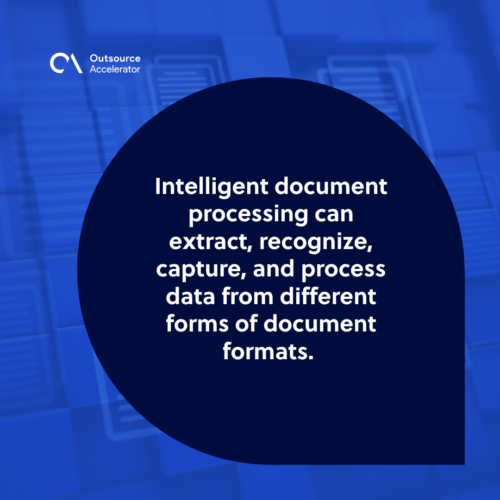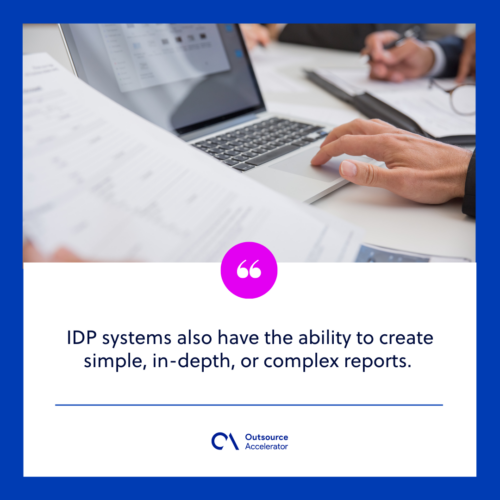Get to know how intelligent document processing works

Our digital age has helped companies to streamline their business landscape for much better and smoother daily operations. Especially with organizations that handle volumes of data, our present technology plays a significant role in carrying out document processing more efficiently.
Document processing is a typical part of many companies’ daily business functions. Through tech innovations, organizations are able to optimize this manual and laborious task.
Today, intelligent document processing has become a crucial part of every business organization’s digital transformation.
Intelligent document processing (IDP)
Intelligent document processing (IDP) is one type of intelligent process automation (IPA)
In IDP, other technologies like machine learning (ML), natural language processing (NLP), or intelligent character recognition (ICR) are also utilized in the process. This helps eliminate mundane repetitive tasks within a process which typically uses human intelligence.
Intelligent document processing can extract, recognize, capture, and process data from different forms of document formats.
This process is highly applicable to companies that work with volumes of unstructured or semi-structured documents. Examples of these are sales orders, invoices, and customer correspondence.
It is important for organizations to be familiar with various intelligent automation solutions below and how they are different from one another to leverage their full capabilities:
IDP system vs OCR Software
An intelligent document processing system came into existence as it is an evolution of optical character recognition (OCR) software. OCR software extracts data out of structured electronic documents. From there, it will convert all information into a text or PDF file that can be edited.
IDP systems, on the other hand, are able to identify and extract information from unstructured documents like emails, articles, or contracts.
Both IDP systems and OCR software take out the need for employees to perform manual data entry. An OCR software, however, has more customization in comparison to IDP systems. Thus, the data extracted by an IDP system is automatically integrated into a business workflow.

IDP system vs RPA software
Robotic process automation (RPA) incorporates artificial intelligence (AI) technology to handle and perform simple daily tasks. Intelligent document processing, as we have mentioned earlier, helps enhance workflows by optimizing unstructured data.
An RPA usually handles structured data and, in some cases, semi-structured data such as invoices. Meanwhile, an intelligent document processing system can handle different forms of data — be it structured, unstructured, or semi-structured.
Where can you use an intelligent document processing system?
IDP is a vital part of intelligent automation. With standard RPA, companies will still be required to pay additional costs to integrate additional features such as data extraction and automation.
Many organizations today incorporate intelligent document processing systems into their RPA platforms to effectively automate their processes from end to end.
To help give clearer insights, IDP systems can be utilized for the following:
Extract specific information
Intelligent document processing helps companies in extracting any information they need from any document. IDP draws out the right information a company requires, be it for storage purposes, for use in other applications, or for further processing.
Manage certain data and documents
IDP can also be used to store, manage, and organize volumes of information and documents. This is highly convenient especially in retrieving documents, records retention automation, and archiving documents.
Digitize physical documents
IDP systems usually incorporate document-scanning features. It converts physical documents into file formats such as PDF, Word, or other Microsoft formats. It also has search capabilities for optimum performance.
Streamline supply chain
This is perfect for businesses with accounts payable processes. Intelligent document processing systems can also work with barcodes, invoices, manifests, and more for quicker supply chain procedures.
Automate documents and create reports
IDP systems also have the ability to create simple, in-depth, or complex reports. Through automated document creation processing, they extract data from different types of sources. They also have document templates that can be utilized in creating reports.
IDP can also be used to process other textual forms that are hard to read. They can be mortgage documents, medical forms, oil and gas documents, and other complex documents.

Wrapping up on intelligent document processing
Intelligent document processing combines a number of data science tools like machine learning, OCR, computer vision, and natural language processing.
These tools are utilized in every stage of document processing. IDP augments human understanding of various forms of data — structured, unstructured, and semi-structured.
Intelligent document processing systems entails the following capabilities:
- Classify and recognize different forms of information
- Process structured, unstructured and semi-structured data
- Has automated data extraction processing
- Incorporate AI and machine learning tools
- Can be integrated with data management software
IDP systems are applicable to the workflows of organizations in various industries. Enterprise-level businesses are often the ones that utilize intelligent document processing as they are already well acquainted with automated workflows.
Another way to leverage IDP is by outsourcing document processing to a reliable provider like SixEleven.
Ultimately, intelligent document processing systems are ideally suited for companies that are processing extensive and complex documents with no strict formatting requirements.







 Independent
Independent




